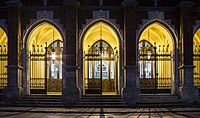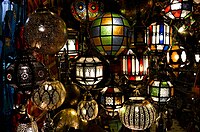Induction lamp

The induction lamp, electrodeless lamp, or electrodeless induction lamp is a gas-discharge lamp in which an electric or magnetic field transfers the power required to generate light from outside the lamp envelope to the gas inside. This is in contrast to a typical gas discharge lamp that uses internal electrodes connected to the power supply by conductors that pass through the lamp envelope. Eliminating the internal electrodes provides two advantages:
- Extended lamp life (internal electrodes are the most limiting factor in lamp life, since their metal content will get sputtered onto the lamp ends every time they are turned on)[citation needed]
- Ability to use higher-efficiency light-generating substances that would react with internal metal electrodes in conventional fluorescent lamps[citation needed]
Two systems are common:
History
In 1882, Philip Diehl (inventor) was awarded a patent for a kind of induction incandescent lamp.[1]
Nikola Tesla demonstrated wireless transfer of power to electrodeless lamps in his lectures and articles in the 1890s, and subsequently patented a system of light and power distribution on those principles.[2]

In 1967 and 1968, John Anderson
In 1990, Michael Ury, Charles Wood and colleagues formulated the concept of the sulfur lamp. With support from the United States Department of Energy, it was further developed in 1994 by Fusion Lighting of Rockville, Maryland, a spinoff of the Fusion UV division of Fusion Systems Corporation. Its origins are in microwave discharge light sources used for ultraviolet curing in the semiconductor and printing industries.
Since 1994, General Electric has produced its induction lamp Genura with an integrated high frequency driver, operating at 2.65 MHz. In 1996, Osram started selling their Endura induction light system, operating at 250 kHz. It is available in the US as the Sylvania Icetron. In 1997, PQL Lighting introduced in the US the Superior Life Brand induction lighting systems. Most induction lighting systems are rated for 100,000 hours of use before requiring absolute component replacements.
In 2005, Amko Solara in Taiwan introduced induction lamps that can dim and use IP (Internet Protocol) based controls. Their lamps have a range from 12 to 400 watts and operate at 250 kHz.
From 1995, the former distributors of Fusion, Jenton / Jenact, expanded on the fact that energised UV-emitting plasmas act as lossy conductors to create a number of patents regarding electrodeless UV lamps for sterilising and germicidal uses.
Around 2000, a system was developed that concentrated radio frequency waves into a solid dielectric waveguide made of ceramic which energized a light-emitting plasma in a bulb positioned inside. This system, for the first time, permitted an extremely bright and compact electrodeless lamp. The invention has been a matter of dispute. Claimed by Frederick Espiau (then of Luxim, now of Topanga Technologies), Chandrashekhar Joshi and Yian Chang, these claims were disputed by Ceravision Limited.[7] A number of the core patents were assigned to Ceravision.[8][9]
In 2006, Luxim introduced a projector lamp product trade-named LIFI. The company further extended the technology with light source products in instrument, entertainment, street, area, and architectural lighting applications among others throughout 2007 and 2008.
In 2009, Ceravision Limited introduced the first
In 2012,
Several companies licensed this technology and it became the viable energy saving solution for lighting retrofit and upgrades before LED lighting reached a viable efficacy solution point. It was widely utilized in roadway and high mast applications around the world replacing 400 watt, 750 watt and 1000 watt metal halide and high pressure sodium systems. The light emitting plasma (LEP) solution was great as it offered a much higher lumen density than its HID counterparts, approximately 50% power reduction and could be at full intensity in around 45-60 seconds from either a cold or hot strike, unlike its HID predecessors.
Plasma lamps

Plasma lamps are a family of light sources that generate light by exciting a
The first plasma lamp was an ultraviolet curing lamp with a bulb filled with argon and mercury vapor, developed by Fusion UV. That lamp led Fusion Systems to develop the sulfur lamp, which concentrates microwaves through a hollow waveguide to bombard a bulb filled with argon and sulfur.
In the past, the
Magnetic induction lamps


Aside from the method of
External core lamps are basically fluorescent lamps with magnetic cores wrapped around a part of the discharge tube. The core is usually made of

Following Faraday's law of induction, the time varying magnetic field in the core generates a time varying electric voltage in any closed path that encloses the time varying magnetic field. The discharge tube forms one such closed path around the ferrite core, and in that manner the time varying magnetic field in the core generates a time varying electric field in the discharge tube, There is no need for the magnetic field to penetrate the discharge tube. The electric field generated by the time varying magnetic field drives the mercury-rare gas discharge in the same way the discharge is driven by the electric field in a conventional fluorescent lamp. The primary winding on the ferrite core, the core, and the discharge form a transformer, with the discharge being a one-turn secondary on that transformer.


The discharge tube contains a low pressure of a rare gas such as
In the internal core form (see diagram), a glass tube (B) protrudes bulb-ward from the bottom of the discharge vessel (A), forming a re-entrant cavity. This tube contains an antenna called a power coupler, which consists of a coil wound over a cylindrical ferrite core. The coil and ferrite form the inductor that couples the energy into the lamp interior
The antenna coils receive electric power from the electronic high frequency driver (C) that generates a high frequency. The exact frequency varies with lamp design, but popular examples include 13.6 MHz, 2.65 MHz and 250 kHz. A special resonant circuit in the driver produces an initial high voltage on the coil to start a gas discharge; thereafter the voltage is reduced to normal running level.
The
In other conventional gas discharge lamps, the electrodes are the part with the shortest life, limiting lamp lifespan severely. Since an induction lamp has no electrodes, it can have a longer service life. For induction lamp systems with a separate driver, the service life can be as long as 100,000 hours, which is 11.4 years of continuous operation. For induction lamps with integrated drivers, the lifespan is in the 15,000 to 50,000 hours range. Extremely high-quality electronic circuits are needed for the driver to attain such a long service life. Such lamps are typically used in commercial or industrial applications. Typically operations and maintenance costs are significantly lower with induction lighting systems due to their industry average 100,000 hour life cycle and five to ten year warranty.
Advantages

- Long lifespan due to the lack of electrodes – strictly speaking, almost indefinite on the lamp but between 25,000 and 100,000 hours, depending on lamp model and quality of electronics used;
- High energy conversion efficiency of between 62 and 90 lumens/watt (higher power lamps are more energy efficient);
Disadvantages
- Some internal inductor lamps that use high-frequency drivers can produce radio frequency interference (RFI) that can interfere with radio communications. Newer external-inductor type lamps use low-frequency drivers that usually have FCCor other certification, thus suggesting compliance with RFI regulations.
- Some types of induction lamps contain mercury, which is highly toxic if released to the environment.
See also
- List of light sources
- Induction cooker
References
- ^ U.S. patent 255,497, Incandescent Electric Lamp, March 28, 1882
- ^ "Experiments with Alternate Currents of Very High Frequency and Their Application to Methods of Artificial Illumination", AIEE, Columbia College, N.Y., May 20, 1891
- ^ John Anderson Biography at the Museum of Electric Lamp Technology
- ^ Electrodeless gaseous electric discharge devices utilizing ferrite cores
- ^ High frequency electrodeless fluorescent lamp assembly
- ^ A History of Heraeus Noblelight Fusion UV and its Industry Leadership in UV Curing Equipment and Products Archived 2012-09-05 at the Wayback Machine
- ^ Ceravision Steps up Legal Action Against Luxim to Recover IP
- ^ Microwave Energized Plasma Lamp with Solid Dielectric Waveguide
- ^ Plasma Lamp with Dielectric Waveguide
- ^ "Topanga technologies". Archived from the original on 2021-03-14. Retrieved 2021-03-24.
- ^ "Stella Electrodeless Xenon ФБ-3000 (FB-3000)".
- ^ Ceravision & Dipolar Form Global Alliance to Take Ultra-Efficient Lighting Technology to... - MILTON KEYNES, England, May 19 /PRNewswire/
- ^ Procedure for Determining Luminaire Efficacy Ratings for High-Intensity Discharge (HID) Industrial Luminaires Archived May 1, 2009, at the Wayback Machine
- ^ "Luxim launches LIFI STA-40 series solid-state plasma light sources". LEDs Magazine. 2008-11-13. Retrieved 2019-10-30.
- ^ "Robe Launches ROBIN 300 Plasma Spot". Robe lighting. 2009-04-27.[dead link]
- ^ "The gift of LIFI: Panasonic projection TVs don't burn out". cnet. 2007-01-09.
External links
- Electrodeless Induction Lamps, Museum of Electric Lamp Technology



